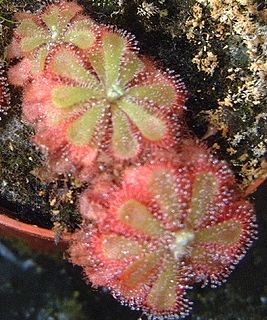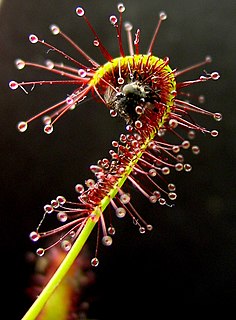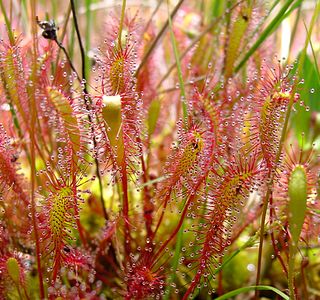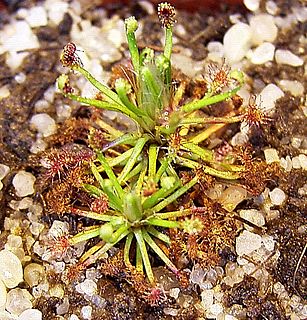
Drosera, which is commonly known as the sundews, is one of the largest genera of carnivorous plants, with at least 194 species. These members of the family Droseraceae lure, capture, and digest insects using stalked mucilaginous glands covering their leaf surfaces. The insects are used to supplement the poor mineral nutrition of the soil in which the plants grow. Various species, which vary greatly in size and form, are native to every continent except Antarctica.

Droseraceae is a family of carnivorous flowering plants, also known as the sundew family. It consists of approximately 180 species in three extant genera. Representatives of the Droseraceae are found on all continents except Antarctica.

Drosera aliciae, the Alice sundew, is a carnivorous plant in the family Droseraceae. It is native to the Cape Provinces of South Africa, like Drosera capensis, the cape sundew, and is one of the most common sundews in cultivation. The plant forms small, tight rosettes of wedge-shaped leaves, up to 5 cm in diameter. Under conditions of good lighting, the insect-snagging tentacles will become deeply coloured with anthocyanin pigments, which probably aid in its attraction of insect prey. The plant is relatively easy to grow, and produces attractive scapes of pink flowers, which are held about 30 cm away from the carnivorous leaves, so as to prevent pollinators from becoming ensnared. D. aliciae is very similar in form to a number of other closely related species such as D. slackii, and D. natalensis: the former is rather larger with a slightly different growth habit(8 cm diameter); the latter has hairier stipules and a larger distance between leaf base and the “sticky” trichomes.

Drosera capensis, commonly known as the Cape sundew, is a small rosette-forming carnivorous species of perennial sundew native to the Cape in South Africa. Because of its size, easy to grow nature, and the copious amounts of seed it produces, it has become one of the most common sundews in cultivation, and thus, one of the most frequently introduced and naturalised invasive Drosera species.

Drosera rotundifolia, the round-leaved sundew, roundleaf sundew, or common sundew, is a carnivorous species of flowering plant that grows in bogs, marshes and fens. One of the most widespread sundew species, it has a circumboreal distribution, being found in all of northern Europe, much of Siberia, large parts of northern North America, Korea and Japan but is also found as far south as California, Mississippi and Alabama in the United States of America and in New Guinea.

Drosera spatulata, the spoon-leaved sundew, is a variable, rosette-forming sundew with spoon-shaped leaves. The specific epithet is Latin for "spatula shaped," a reference to the form of the leaves. This sundew has a large range and occurs naturally throughout Southeast Asia, southern China and Japan, Micronesia, Papua New Guinea, eastern Australia, Tasmania and New Zealand. Variants are often known by the localities in which they are found. The plant does not form hibernacula in winter, and is easily grown using the same methods as Drosera capensis.

Drosera regia, commonly known as the king sundew, is a carnivorous plant in the sundew genus Drosera that is endemic to a single valley in South Africa. The genus name Drosera comes from the Greek word droseros, meaning "dew-covered". The specific epithet regia is derived from the Latin for "royal", a reference to the "striking appearance" of the species. Individual leaves can reach 70 cm (28 in) in length. It has many unusual relict characteristics not found in most other Drosera species, including woody rhizomes, operculate pollen, and the lack of circinate vernation in scape growth. All of these factors, combined with molecular data from phylogenetic analysis, contribute to the evidence that D. regia possesses some of the most ancient characteristics within the genus. Some of these are shared with the related Venus flytrap (Dionaea muscipula), which suggests a close evolutionary relationship.

Drosera pedicellaris is a pygmy species of the sundew genus (Drosera). It was discovered in 1997 and described in 2002 by Allen Lowrie.

Drosera anglica, commonly known as the English sundew or great sundew, is a carnivorous flowering plant species belonging to the sundew family Droseraceae. It is a temperate species with a circumboreal range, although it does occur as far south as Japan, southern Europe, and the island of Kauai in Hawaii, where it grows as a tropical sundew. It is thought to originate from an amphidiploid hybrid of D. rotundifolia and D. linearis, meaning that a sterile hybrid between these two species doubled its chromosomes to produce fertile progeny which stabilized into the current D. anglica.

Drosera madagascariensis is a carnivorous plant of the sundew genus (Drosera). It was described in 1824 by A. P. de Candolle and is native to Africa.

Drosera intermedia, commonly known as the oblong-leaved sundew, spoonleaf sundew, or spatulate leaved sundew, is an insectivorous plant species belonging to the sundew genus. It is a temperate or tropical species native to Europe, southeastern Canada, the eastern half of the United States, Cuba, Hispaniola, and northern South America.

Drosera burmanni, the tropical sundew, is a small, compact species in the carnivorous plant genus Drosera. Its natural geographical range includes the tropical and subtropical regions of Asia, Australia, India, Japan,southeast Asia,Oceania, Africa and China 's Guangxi, Guangdong, Yunnan, Fujian, Taiwan. It normally spans only 2 cm (0.8 in) in diameter. It is one of the fastest trapping sundews as well, and its leaves can curl around an insect in only a few seconds, compared to the minutes or hours it takes other sundews to surround their prey. In nature, D. burmanni is an annual, but in cultivation, when grown indoors during the cold months, it can live for many years. Since D. burmanni is an annual, it produces large amounts of seed. Drosera burmanni has been considered a powerful rubefacient in Ayurveda.

Drosera indica is an insectivorous plant, a sundew native to tropical countries throughout the world, from Asia to Africa, but absent from the neotropics. Together with Australian endemic species D. aquatica, D. aurantiaca, D. barrettorum, D. cucullata, D. finlaysoniana, D. fragrans, D. glabriscapa, D. hartmeyerorum, D. nana, D. serpens it makes up the section Arachnopus.

Drosera whittakeri is a sundew that is native to South Australia and Victoria.

Drosera cistiflora is a species of sundew, known for its unusually large flowers. It is native to southern Africa.

Drosera slackii is a subtropical sundew native to the Cape Provinces of South Africa. It forms rosettes that range from to two to four inches in diameter, and produces pink flowers. It is named after the British plantsman and author Adrian Slack (1933-2018).

Drosera glanduligera, the pimpernel sundew, is a rosetted annual species in the carnivorous plant genus Drosera that is endemic to Australia. It is 2.5–6 cm (1–2 in) tall and grows in most soil conditions. It produces orange flowers from August to November. It was originally described in 1844 by Johann Georg Christian Lehmann. It is the sole species in the subgenus Coelophylla, which Jan Schlauer elevated from section rank in 1996; it was originally described by Jules Émile Planchon in 1848.

Drosera meristocaulis is a perennial species in the carnivorous plant genus Drosera, the only member of the subgenus Meristocaulis. It is a small, rosette- and branched stem-forming sundew that has many morphological affinities to the Australian pygmy sundews. D. meristocaulis is wholly endemic to Pico da Neblina, an isolated mountain on the Brazil-Venezuela border.
Drosera peruensis is a carnivorous plant of the genus Drosera, commonly known as the Peruvian sundew. This Drosera species was first identified in Peru in 2002 by Tânia Regina dos Santos Silva and Mireya D. Correa following work to update the genus Drosera for the reference text, Flora Neotropica..

Drosera admirabilis, commonly referred to as the "floating sundew", is in the carnivorous us plant family Droseraceae. The nickname "admirabilis" was first used in literature by Paul Debbert in 1987 and was derived from how "admirable" the plant appears when it reaches a fully matured specimen. Structurally similar to Drosera aliciae, and Drosera cuneifolia, the D. admirabilis grows in a single tight rosette-shaped leaf bundle. The leaves widen towards the end and have rounded tips. Leaves lay horizontally under proper lighting conditions. Like many other African sundews, D. admirabilis is a perennial. D. admirabilis has outer tentacles like those of Drosera glanduligera, Drosera sessilifolia and Drosera burmannii which briefly after stimulation bend towards the prey.



















